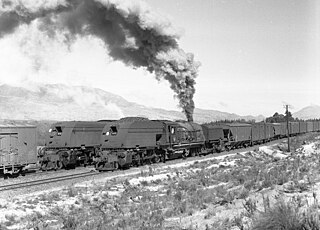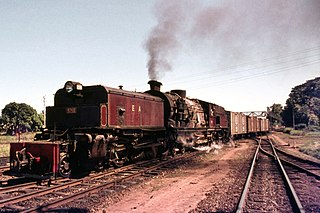
A Garratt is a type of steam locomotive invented by British engineer Herbert William Garratt that is articulated into three parts. Its boiler, firebox, and cab are mounted on a centre frame or "bridge". The two other parts, one at each end, have a pivot to support the central frame; they consist of a steam engine unit – with driving wheels, trailing wheels, valve gear, and cylinders, and above it, fuel and/or water storage.
Beyer, Peacock and Company was an English railway locomotive manufacturer with a factory in Openshaw, Manchester. Founded by Charles Beyer, Richard Peacock and Henry Robertson, it traded from 1854 until 1966. The company exported locomotives, and machine tools to service them, throughout the world.

The Indian Railways primarily operates fleet of electric and diesel locomotives, along with several compressed natural gas (CNG) locomotives. Steam locomotives are operated on a few World Heritage Sites and also run occasionally as heritage trains. A locomotive is also known as a loco or more popularly as an engine. The country's first steam locomotive ran on the Red Hill Railway from Red Hills to the Chintadripet bridge in Madras in 1837.

Under the Whyte notation for the classification of steam locomotives by wheel arrangement, the 2-8-0+0-8-2 is a Garratt articulated locomotive. The wheel arrangement is effectively two 2-8-0 locomotives operating back to back, with the boiler and cab suspended between the two power units. Each power unit has a single pair of leading wheels in a leading truck, followed by four coupled pairs of driving wheels and no trailing wheels. Since the 2-8-0 type is sometimes known as a Consolidation, the corresponding Garratt type could be referred to as a Double Consolidation.

The Sierra Leone Government Railway operated in Sierra Leone from 1897 to 1974. It was unusual in that it formed a national railway system constructed solely to a 2 ft 6 in narrow gauge, whereas in other countries, gauge of such a narrow width was usually confined to feeder railways.

The South African Railways Class GL 4-8-2+2-8-4 of 1929 was an articulated steam locomotive.
Under the Whyte notation for the classification of steam locomotives by wheel arrangement, a 4-8-2+2-8-4 is a Garratt articulated locomotive consisting of a pair of 4-8-2 engine units back to back, with the boiler and cab suspended between them. The 4-8-2 wheel arrangement has four leading wheels on two axles, usually in a leading bogie, eight powered and coupled driving wheels on four axles and two trailing wheels on one axle, usually in a trailing truck. Since the 4-8-2 type is generally known as a Mountain, the corresponding Garratt type is usually known as a Double Mountain.

Under the Whyte notation for the classification of steam locomotives by wheel arrangement, the 4-8-0+0-8-4 is a Garratt articulated locomotive. The wheel arrangement is effectively two 4-8-0 locomotives operating back to back, with the boiler and cab suspended between the two engine units. Each engine unit has two pairs of leading wheels in a leading bogie, followed by four coupled pairs of driving wheels and no trailing wheels. Since the 4-8-0 type is known as a Mastodon type, the corresponding Garratt type would be referred to as a Double Mastodon. A similar wheel arrangement exists for Mallet locomotives, but is referred to as 4-8-8-4.

The AD60 class were Beyer-Garratt patent articulated four-cylinder, simple, non-condensing, coal-fired superheated, 4-8-4+4-8-4 heavy goods steam locomotives built by Beyer, Peacock and Company for the New South Wales Government Railways in Australia.

The South African Railways Class GEA 4-8-2+2-8-4 of 1946 was an articulated steam locomotive.

The South African Railways Class GO 4-8-2+2-8-4 of 1954 was an articulated steam locomotive.
The Indian locomotive class XC was a class of heavy axle load 4-6-2 "Pacific" type steam locomotives used on 5 ft 6 in broad gauge lines in British India, and then in post-partition India and Pakistan.
The Bengal Nagpur Railway class HSG was a class of two 2-8-0+0-8-2 Garratt locomotives.

The DHR D Class was a 2 ft gauge 0-4-0+0-4-0 Garratt-type articulated steam locomotive used on the Darjeeling Himalayan Railway (DHR) in West Bengal, India.

The KUR EC3 class, later known as the EAR 57 class, was a class of 1,000 mm gauge 4-8-4+4-8-4 Garratt-type articulated steam locomotives. The twelve members of the class were built by Beyer, Peacock & Co. in Manchester, England, for the Kenya-Uganda Railway (KUR). They entered service between 1939 and 1941, and were later operated by the KUR's successor, the East African Railways (EAR).
The KUR EC class was a class of 1,000 mm gauge 4-8-2+2-8-4 Garratt-type articulated steam locomotives built by Beyer, Peacock & Co. in Manchester, England, for the Kenya-Uganda Railway (KUR).

The KUR EC2 class, later known as the EAR 52 class, was a class of 1,000 mm gauge 4-8-2+2-8-4 Garratt-type articulated steam locomotives operated by the Kenya-Uganda Railway (KUR) and the East African Railways (EAR).

The TR GA class, later known as the EAR 53 class, was a class of 1,000 mm gauge 4-8-2+2-8-4 Garratt-type articulated steam locomotives. The three members of the class were built in 1930 by Beyer, Peacock & Co. in Manchester, England, for the Tanganyika Railway (TR). They entered service in 1931, and, with one exception, were later operated by the TR's successor, the East African Railways (EAR).

The EAR 56 class was a class of 1,000 mm gauge 4-8-2+2-8-4 Garratt-type articulated steam locomotives built by Beyer, Peacock & Co. in Gorton, Manchester, England, in 1949. The six members of the class were ordered by the Kenya-Uganda Railway (KUR) immediately after World War II, and were a slightly modified version of the KUR's existing EC5 class.

The KUR EC5 class was a class of 1,000 mm gauge 4-8-2+2-8-4 Garratt-type articulated steam locomotives built during the latter stages of World War II by Beyer, Peacock & Co. in Gorton, Manchester, England, for the War Department of the United Kingdom. The two members of the class entered service on the Kenya-Uganda Railway (KUR) in 1945. They were part of a batch of 20 locomotives, the rest of which were sent to either India or Burma.



















